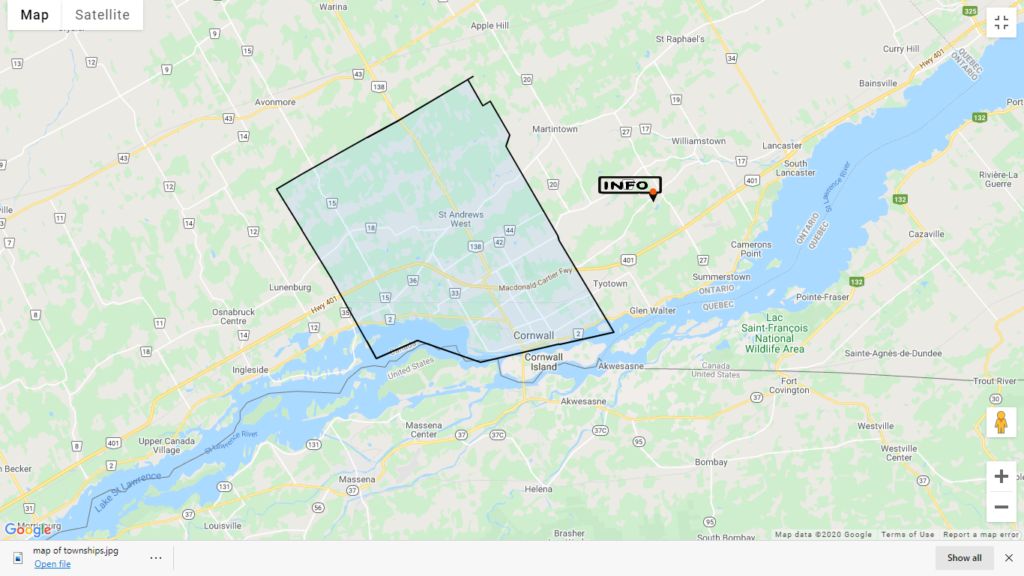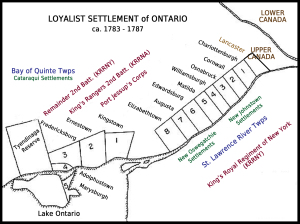History of Cornwall Township
The Jesmer family moved for Montreal, eastward towards Cornwall Township. They were competing for farmland with British Loyalist Refugees from the American Revolutionary War and from Scottish settlers. They also had to endure various skirmishes during the war of ` 1812. They were French speaking and Catholic. Most of those in conflicts were English speaking and Protestant. I think that the average Frech Canadians stayed out of the conflicts and worked hard to make a living. They also formed bonds with the Irish. In 1814 a few families became Americans and settled on the other side of the St Lawrence River. The French Canadians were laborers and farmers. Some made the trek from Montreal Cornwall on foot!


Cornwall Twp. in historical STORMONT Co.
“A prosperous farming and dairying district tributary to the town of Cornwall. Settled in 1785 by veterans of Sir John Johnson’s and other Loyalist corps. The town of Cornwall, on the St. Lawrence, is the oldest community in Eastern Ontario, first surveyed as a town plot in 1786. Under the name of New Johnstown it was the centre of the Loyalist settlement in Glengarry, Stormont and Dundas immediately after the Revolution.”
Jesse E. Middleton, The Province of Ontario: a History: 1615-1927, published 1927
With the 1957 expansion of the St. Lawrence Seaway / International Rapids hydro-electric power project, riverfront communities in this township were permanently surrendered to water.
Cornwall: The City that Keeps Changing
History of the Wood House
The museum’s stone building was built by the Wood Family. United Empire Loyalists, Jonas and Sarah Wood, arrived at the future site of Cornwall in 1784. Here, along with hundreds of other Tory refugees, they drew lots for their new homesteads, replacing the property they lost in the former 13 Colonies. In 1806, son, William Wood, with his wife, Sarah Dixon, purchased 200 acres just west of Cornwall, facing the St. Lawrence River and bordering the river road. There, they first built an inn, then, around 1840, constructed the present house from stone that was either from the Cornwall Canal, or meant for a British fort that was never built. Three generations of the Wood family lived in the house until 1952 when Walter Wood, a bachelor, died. Several years later, it became Cornwall and the United Counties’ first museum. A wealth of information about the Wood family and other pioneers are housed within the museum. We invite you to come and see the unique beauty of this building. Each step you take will echo those taken by the many who lived in or visited this significant site.
Our Roots
After the 8.5 year American Revolutionary War / the American War of Independence (from Great Britain) ended in September of 1783, eight consecutive Loyalist Townships were created along the north shore of the St. Lawrence River and five others along the Bay of Quinte to house some 80,000 refugees who desired to remain loyal to the British Crown and as a defence strategy against the Americans who had been invading what remained of British North America, seeking to enlarge their country.
The Royal Townships
The St. Lawrence River and Bay of Quinte townships were “royal” in that they were named after British royalty from east to west according to date of birth. At their own request, the people were originally settled in communities according to ethnicity and religion. The area that would eventually be called Lancaster Township was known as the “sunken township” or “Lake Township” (after nearby Lake St. Francis) as it was originally thought to be too wet or low-lying to be of much use. The dense forest and swamps were unexplored except by the indigenous people. The expanded list of townships was solidified in 1788, the same year that the U.S. Constitution was ratified.
St. Lawrence River Townships:
Township Named after Predominantly
Lancaster Duke of Lancaster who became King George III (b. 1738) Royal Yorkers (1785)
Charlottenburg Queen Charlotte (b. 1744) Roman Catholic Highlanders in the Royal Yorkers
Cornwall Duke of Cornwall who became King George IV (b. 1762) Scottish Presbyterians in the Royal Yorkers
Osnabruck Bishop of Osnabruk, Prince Frederick (b. 1764) German Calvinists in the Royal Yorkers
Williamsburgh Prince William (b. 1765) German Lutherans in the Royal Yorkers
Matilda Princess Charlotte Matilda (b. 1766) Anglicans in the Royal Yorkers
Edwardsburg Prince Edward (b. 1767) Major Jessup’s Loyal Rangers
Augusta Princess Augusta (b. 1768) Major Jessup’s Loyal Rangers
Elizabethtown Princess Elizabeth (b. 1770) Major Jessup’s Loyal Rangers
Sir John Johnson sought and obtained a commission to organize and settle the Loyalist families on lands that he assigned to them. The fist settlement was carried out in April and May of 1784 on the front concessions of what became Glengarry and Stormont. Dundas settlement began in June.
Other Loyalist settlements were at Sidney Township (no specific group) and in the Niagara Region, which was predominantly Butler’s Rangers.
Prior to 1784 there were only a few scattered settlements along the St. Lawrence River. The resettlement of these Loyalists to what is now Southern Ontario was crucial to the eventual founding of Ontario. Had they not been here in numbers in the 1790s with established government, laws and military might to defend the land, there is little doubt that the Canada we know would not exist; we’d be Americans. It’s been said that the American Revolution spawned two countries, not one. Millions of Canadians can trace their roots to a Loyalist ancestor.
The Township of Cornwall was proclaimed by Lord Dorchester on July 24, 1788 with the formation of the Lunenburgh District and was comprised of approximately one-third German, one-third Scotch and one-third English residence. Cornwall Township incorporated in 1850 and ceased to exist as of January 1, 1998.
What’s in a Name?
New Johnstown was named after Sir John Johnson, 2nd Baronet of New York, a Loyalist leader during the American Revolution. New Johnstown (temporarily known as Royal Town #2) was founded June 6, 1784 as a one square mile United Empire Loyalist town in the Montreal District of the former British Province of Quebec (in 1791 Upper Canada). In 1776 Johnson had arrived with an advance party to survey and plan a series of townships. Contrary to local lore, no pre-existing permanent community was on the town site. The presence of treacherous rapids led to the First Nations people establishing some portage points along the shoreline outside of what was to become the Square Mile town. The European settlers also used those portage points, generally on their way to explore the Great Lakes, but there exists no record of any attempt at creating a trading post, military stronghold nor permanent settlement and occupation here prior to the arrival of the Loyalists. In 1789 the New Johnstown Post Office was established. The original Square Mile ran from the north side of Water Street to the south side of Ninth Street and from the east side of Cumberland Street to the west side of Marlborough Street. The Square Mile major streets are a tenth of a mile apart.
Edward,_Duke_of_Kent_and_Strathearn_by_Sir_William_Beechey
Prince Edward Augustus, Duke of Cornwall – National Portrait Gallery, London as depicted by Sir Wm Beechey in 1818.
New Johnstown was re-named Cornwall in 1792 in honour of Prince Edward Augustus (1767-1820), Duke of Cornwall. Edward, the fourth son of King George III, was assigned to oversee the military in British Upper and Lower Canada from 1791-1800 and later became King George IV. Some purport that the name Cornwall was used as early as 1789. The first Town lot patent dates to 1803.
The north-south streets in the Mile Square are named after British royalty and aristocracy.
David Murray On June 16, 1792, the province of Upper Canada was divided into counties. Stormont County is named after David Murray, 7th Viscount Stormont, 1727-96. This portrait hangs in the British Museum and is in the Public Domain.
Square Mile Street Name Named after
Cumberland Street William Augustus (1721-1765), Duke of Cumberland
Bedford Street Lord John Russell (1710-1777), 4th Duke of Bedford
York Street Frederick Augustus (1763-1827), Duke of York
Augustus Street Frederick Augustus (1763-1827), Duke of York
Pitt (Main) Street William Pitt (1759-1806), Prime Minister of England
Sydney (Sidney) Street Thomas Townsend (1733-1800), Lord Sydney
Amelia Street Princess Amelia (1711-1786), daughter of King George II
Adolphus Street Prince Adolphus Frederick (1774-1850), son of King George III
Gloucester (Glocester) Street William Henry (1743-1805), 1st Duke of Gloucester
Marlborough Street John Churchill (1650-1722), 1st Duke of Marlborough
comparativetimeline
Water Transportation
Early navigation of the St. Lawrence River was difficult due to the treacherous rapids at Long Sault and Cornwall. To bypass the rapids, on February 13, 1833 construction of the Cornwall Canal was officially authorized and the official sod-turning took place on August 5, 1834. Construction commenced shortly thereafter. Lack of funds and the economic depression on the heels of the 1837 Upper Canada Rebellion against the Family Compact resulted in a work stoppage from 1838 to 1841. The 11 mile original project was complete by November of 1842, consisting of six locks. By 1891 another five locks had been added. 1958 saw the opening of the new international Seaway Project which wiped out half of the canal and made the rest of it largely unnecessary.






Interact with us using Facebook